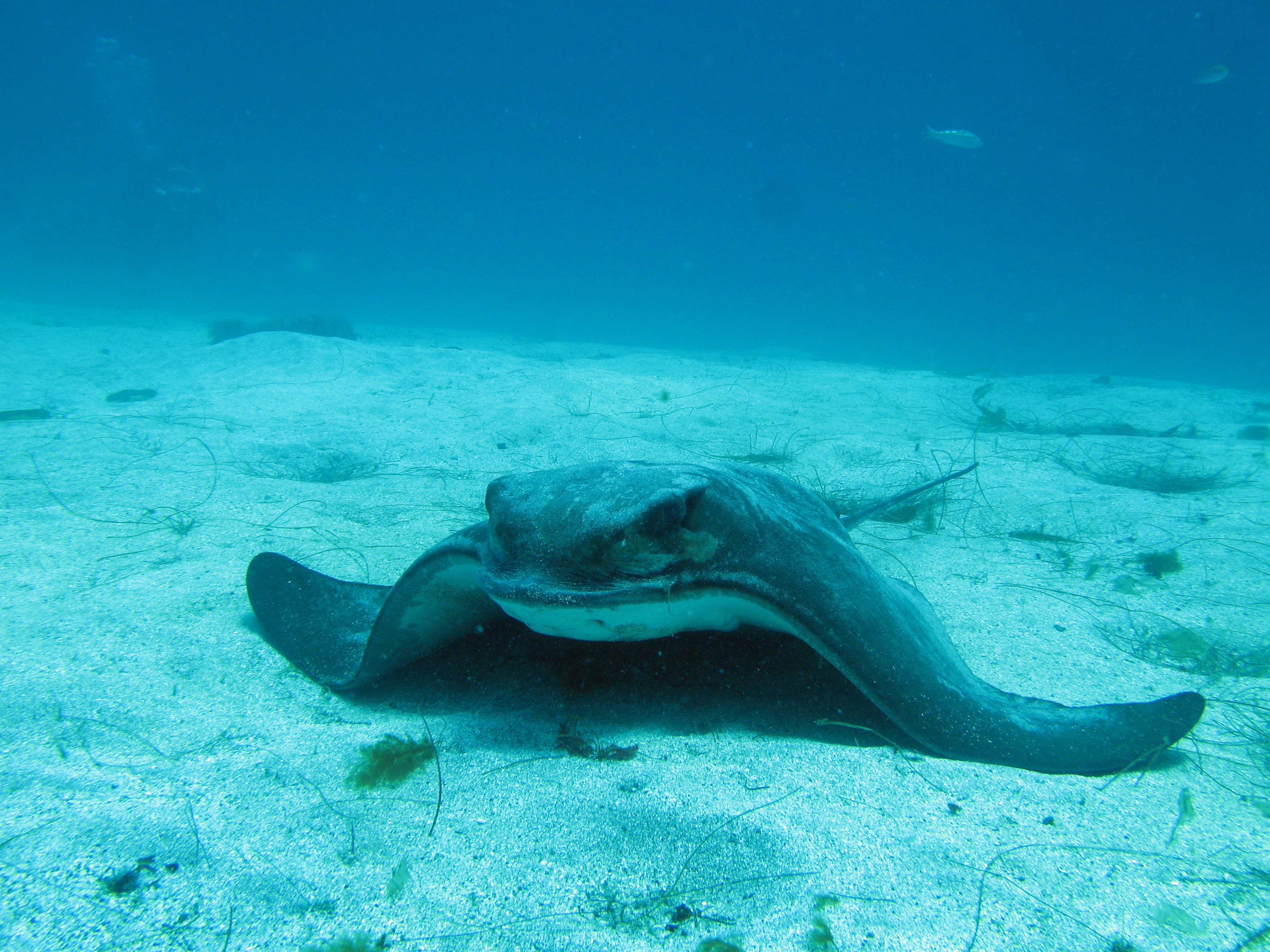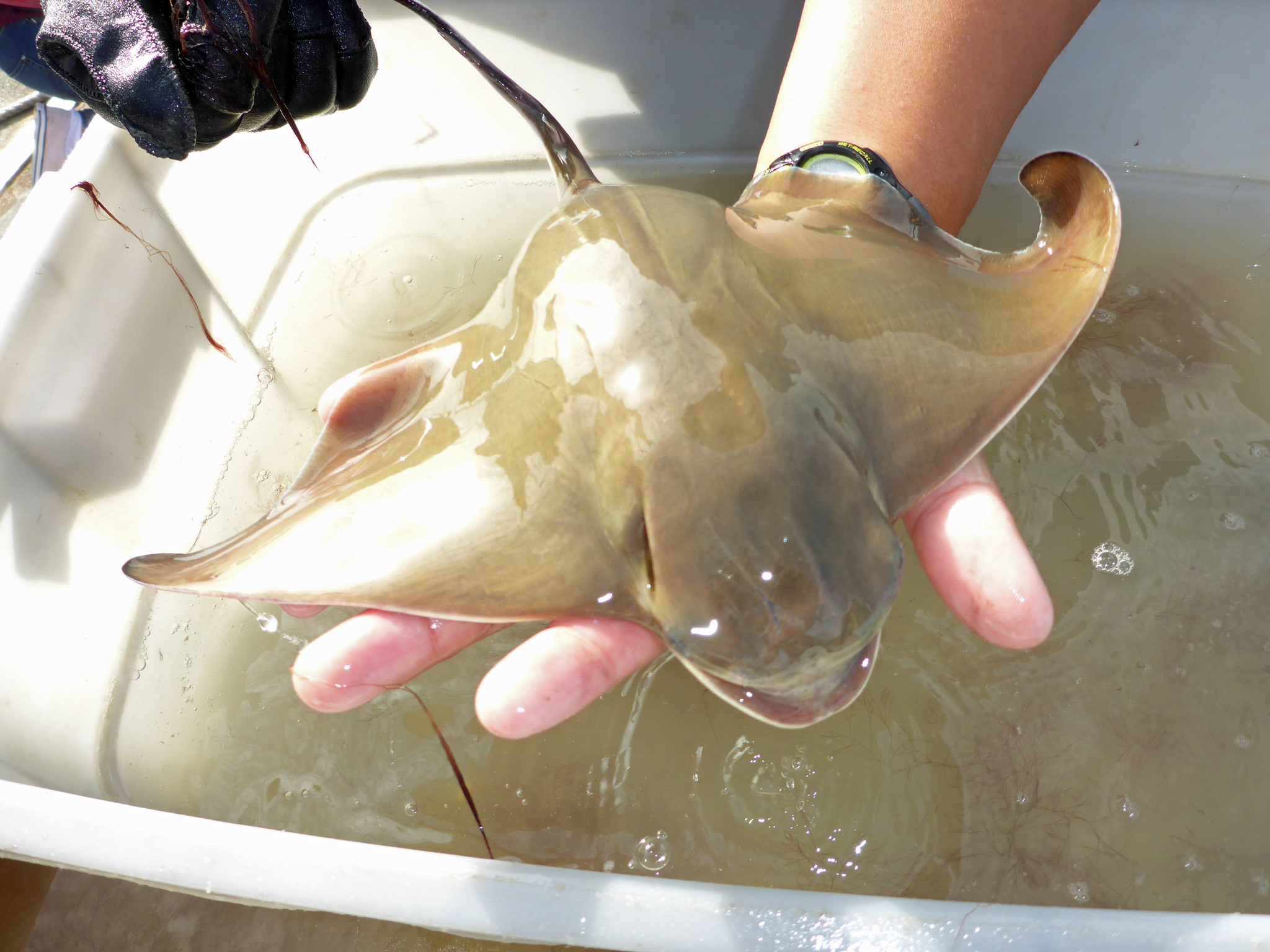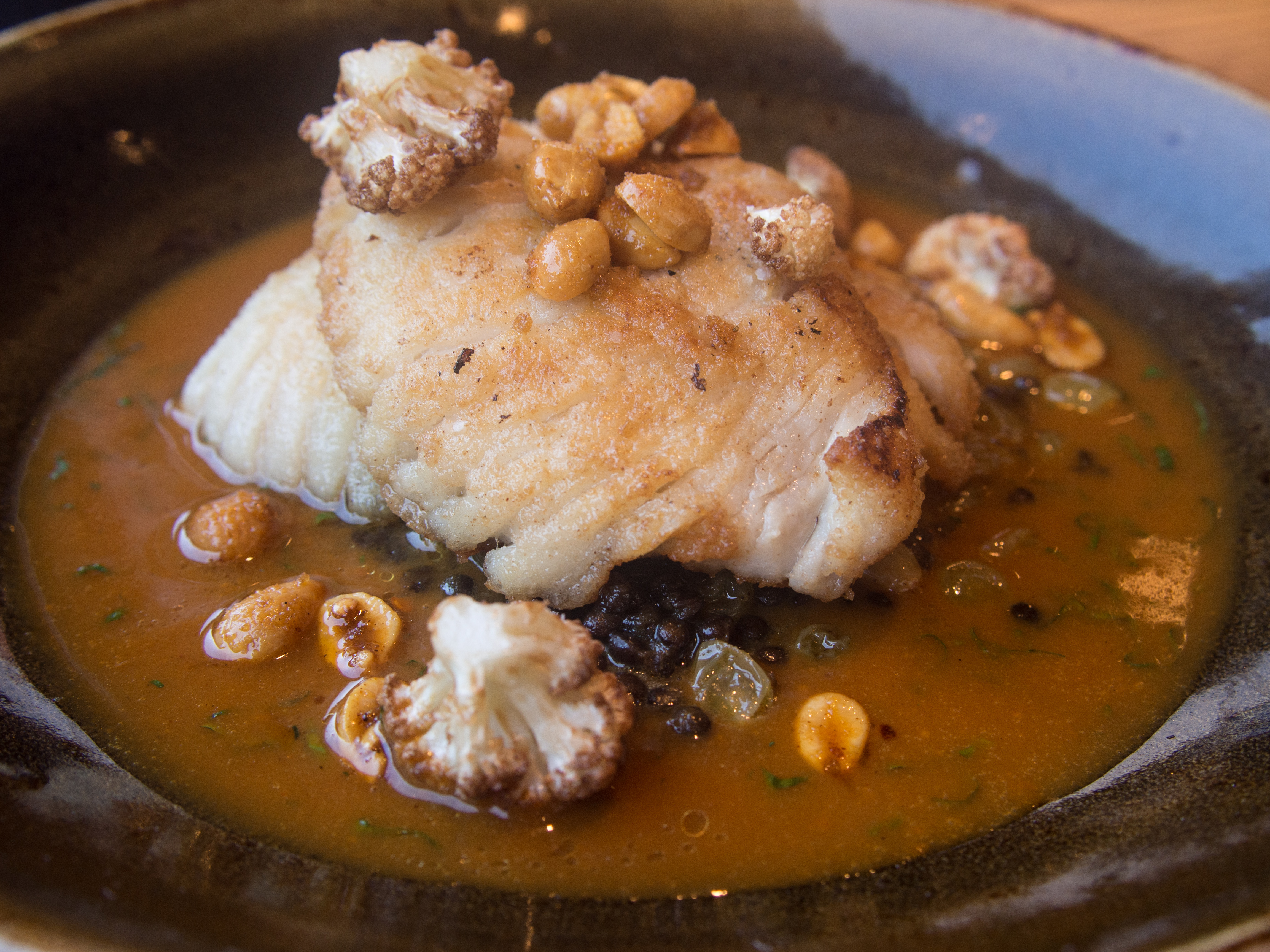Myliobatis californica
North Coast (Oregon Border to Point Arena)
North Central Coast (South of Point Arena to Half Moon Bay)
Central Coast (South of Half Moon Bay to Point Conception)
Santa Barbara (Point Conception to Point Dume)
South Coast (Point Dume to Mexico border)
Firm fish
Wild caught

The Science

Taxonomic description
- Black or brown back with a white belly. [2]
- Has a long, thin tail with a stinger behind its dorsal fin at the base of its tail. [2,16]
- Has a distinctive protruding head and bat-like “wings” for propulsion through the water. [2]
- Females can grow up to 2 m (6 ft) across and weigh 90 kg (200 lbs); males are smaller with the largest caught at about 1 m (3 ft) across and 17 kg (37 lbs). [1,7]
Distribution
- Found in the Eastern Pacific, from Oregon to Mexico. [2,13]
Life history
- Lives up to 23 years solitarily or in schools; females aggregate during mating in the spring/summer. [1,9,16]
- Before mating, the male swims behind the female to detect chemical signals that indicate her reproductive status; during mating, the male swims underneath the female. [16]
- Reproduces via live birth. [16]
- Litter size of two to ten pups, with a gestation period of nine to twelve months. [1]
Habitat
- Lives in the intertidal to max depth of 180 meters (590 ft); with nurseries in shallow waters of bays and sloughs. [13]
- Prefers flat sandy seafloor with rocks. [1,2]
- Burrows with its snout and flaps its wings to uncover mollusks, crustaceans and small fish prey on the sandy seafloor; other fish take advantage of this behavior to find “leftovers” in the pit that is formed. [1]
- Its predators include sea lions, white sharks, broadnose sevengill sharks and humans through sportfishing or incidental catch in commercial fisheries. [1,6,13]
- Previously thought to disturb oyster fields, but it was recently discovered that bat rays eat crabs, a primary predator of oysters. [1]
The Fishery

Seasonal availability
- Available year round, but catch is lowest in spring in southern California. [4,13]
Regulatory and Managing authority
- As established by the Marine Life Management Act, the California Fish and Game Commission (CFGC) regulates the fishery, and the California Department of Fish and Wildlife (CDFW) manages this fishery in state waters. [8,15]
- As bat ray is not a commercially targeted species, there are currently no formal management plans in place but this fishery is monitored. [15]
- The Groundfish Collective combines input from the industry and government entities to inform regulatory and management measures for this fishery. [18]
Gear type
- The best baits to use are squid or mackerel, fresh or frozen. [2,3,14]
- Caught by troll, longline, gillnet, hook and line, and trawl (with limited entry). [12]
Status of the fishery
- Although not specifically regulated, but restrictions on entry and gear (e.g. nearshore gillnets) provide protection. [13]
- Stocks are considered stable and increasing; it has an IUCN status of “Least Concern” since 2006. [13]
- Fishing for bat ray as a pest of oyster beds was virtually eliminated by 1994. [13]
- There is little abundance information; catch increased from 47% to 68% of fishing derby catch from the 1950s to 90s. .[13]
Potential ecosystem impacts
- Most of the incidental catch of rays is from trawling, which is regulated through limited entry. [12]
The Seafood

Edible portions
- Usually only the wings are eaten (entire wing cut into filets). [11]

Description of meat
- The meat is tender but meaty; similar to skate. [11]
- It has been compared to white fish and scallops. [10,5]
Culinary uses
- Available whole or skinned and filleted, fresh or frozen. [10]
- If preparing fresh-caught, remove slime by rubbing the wing down with coarse salt or a scrub brush in the sink, slice meat off cartilage, filet like fish, brine, and age filets in fridge for a few days. [11]
- Prepare as you would any other fish, but recommend cooking methods are sautéing, deep-frying or poaching. [10, 11]
- For a Singaporean and Malaysian recipe for barbequed sambal sting ray, visit Food.com. [19]
Nutritional information
- Nutrition Facts table given for skate (similar to rays). [17]
Toxicity report
- As the bat ray processes urea through its skin, it can develop an ammonia smell if handled improperly. Avoid buying pieces that smell like ammonia and when sport fishing, eliminate gut immediately after obtaining and put on ice. [10,11]
Seasonal availability
- This fish is available year round. [13]
References
[1] Monterey Bay Aquarium. 2017. Bat Ray. Web. https://www.montereybayaquarium.org/animal-guide/fishes/bat-ray. Accessed: 12 April 2017.
[2] Jones, K. 2004. Pier fishing in California: the complete coast and bay guide. 2nd ed. Roseville, CA: Publishers Design Group. CA,USA.
[3] Prehistoric Soul. 2014. Bat Ray Fishing in Southern California Bays. Web. http://prehistoricsoul.com/link-post-format-with-left-oriented-sidebar/. Accessed: 12 April 2017.
[4] California Department of Fish and Wildlife. Commercial Fishing, Web. https://www.wildlife.ca.gov/fishing/commercial. Accessed: 20 May 2017.
[5] Dunaway, V. 2012. Cooking Stingray and Skates. Web. http://www.floridasportsman.com/2012/08/13/cooking-stingray-and-skates/. Accessed: 20 May 2017.
[6] Jones, K. 2011. The Mighty Mud Marlin. Web. http://kenjonesfishing.com/articles/the-mighty-mud-marlin/. Accessed: 20 May 2017.
[7] Jones, K. 2015. Bat Ray. Web. http://kenjonesfishing.com/2015/08/bat-ray/. Accessed: 20 May 2017.
[8] Marine Life Management Act. Web. https://www.wildlife.ca.gov/Conservation/Marine/MLMA. Accessed: 20 May 2017.
[9] Myliobatis californica Bat Eagle Ray. Web. https://eol.org/pages/46561010. Accessed: 31 April 2017.
[10] Oulton, R. 2007. Skate. Web. http://www.cooksinfo.com/skate. Accessed: 20 May 2017.
[11] Shaw, H. Loving the Unloved: Bat Rays. Web. http://honest-food.net/bat-ray-recipe/. Accessed: 31 April 2017.
[12] Trawl Regulations & Compliance Guidelines. Web. http://www.westcoast.fisheries.noaa.gov/fisheries/groundfish_catch_shares/rules_regulations/trawl_regulations_compliance_guides.html. Accessed: 26 May 2017.
[13] van Hees, K. 2015. Myliobatis californicus. Web. http://www.iucnredlist.org/details/39416/0. Accessed: 31 April 2017.
[14] Yeh, A. 2015. Shark and Ray Fishing. Web. http://www.scalzfishing.com/shark-and-ray-fishing/. Accessed: 12 April 2017.
[15] California Department of Fish and Wildlife. Marine Species Portal. 2020. Web. https://marinespecies.wildlife.ca.gov/bat-ray/false/. Accessed 28 October 2020.
[16] 2013. Bat Rays, Myliobatis californica. Web. https://marinebio.org/species/bat-rays/myliobatis-californica/. Accessed: 31 April 2017.
[17] Bat Ray. Web. Nutritiondata.self.com. Accessed: 21 September 2017.
[18] California Groundfish Collective. n.d. Web. http://www.cagroundfish.org/#our-story. Accessed 28 October 2020.
[19] Food.com. 2004. BBQ Sambal Sting Ray/Fish. Web. https://www.food.com/recipe/bbq-sambal-sting-ray-fish-80144. Accessed 8 January 2020.
[20] shellsan. flickr. 2010. Bat Ray. Digital image. Web. https://www.flickr.com/photos/shellsan/4701746135/. Accessed 11 February 2021.
[21] anudibranchmom. iNaturalist. 2018. Bat Ray. Digital image. Web. https://www.inaturalist.org/observations/16535152. Accessed 11 February 2021.
[22] Little, E. flickr. 2013. Family Meal - Skate Wing. Digital image. Web. https://www.flickr.com/photos/edsel_/8578025847/. Accessed 11 February 2021.
